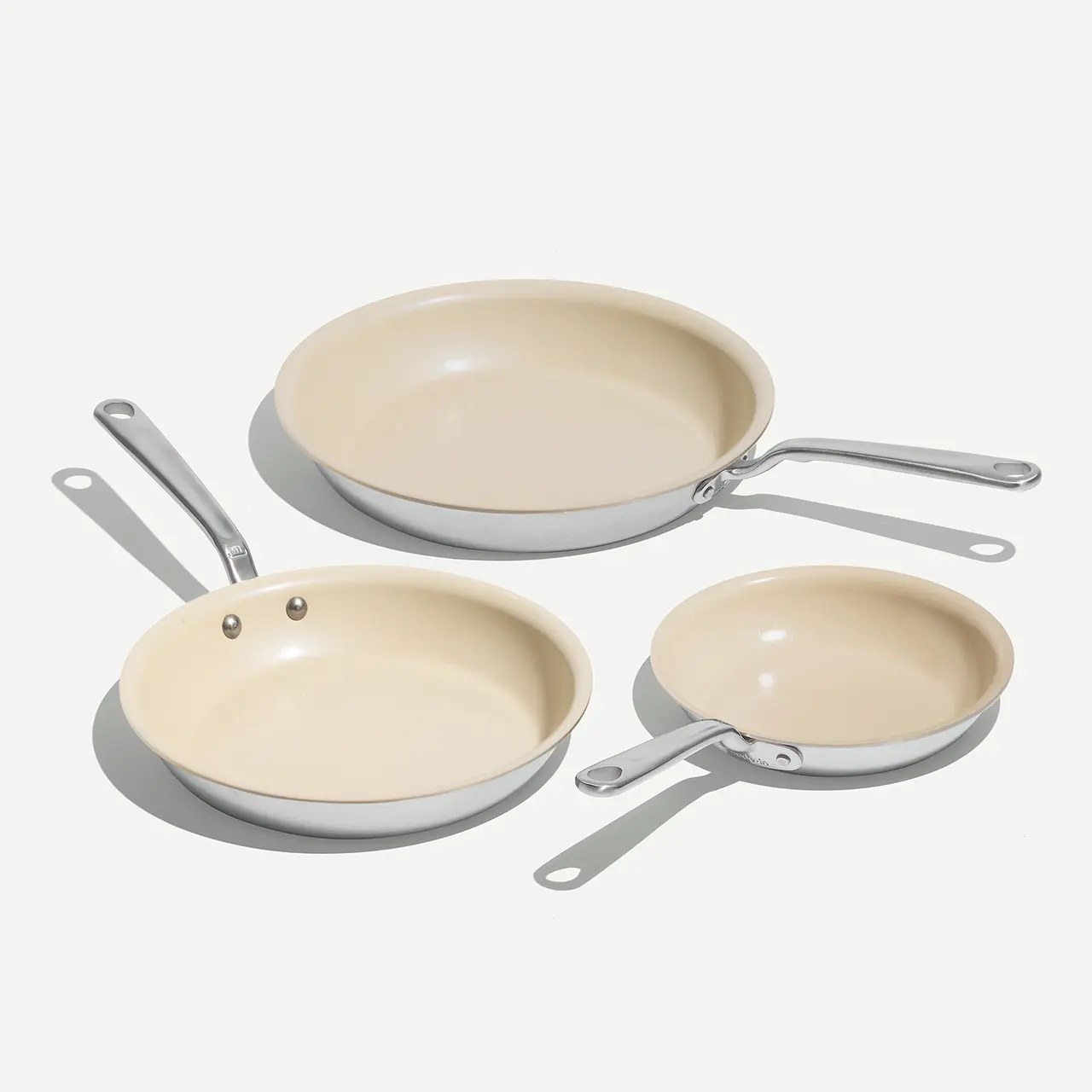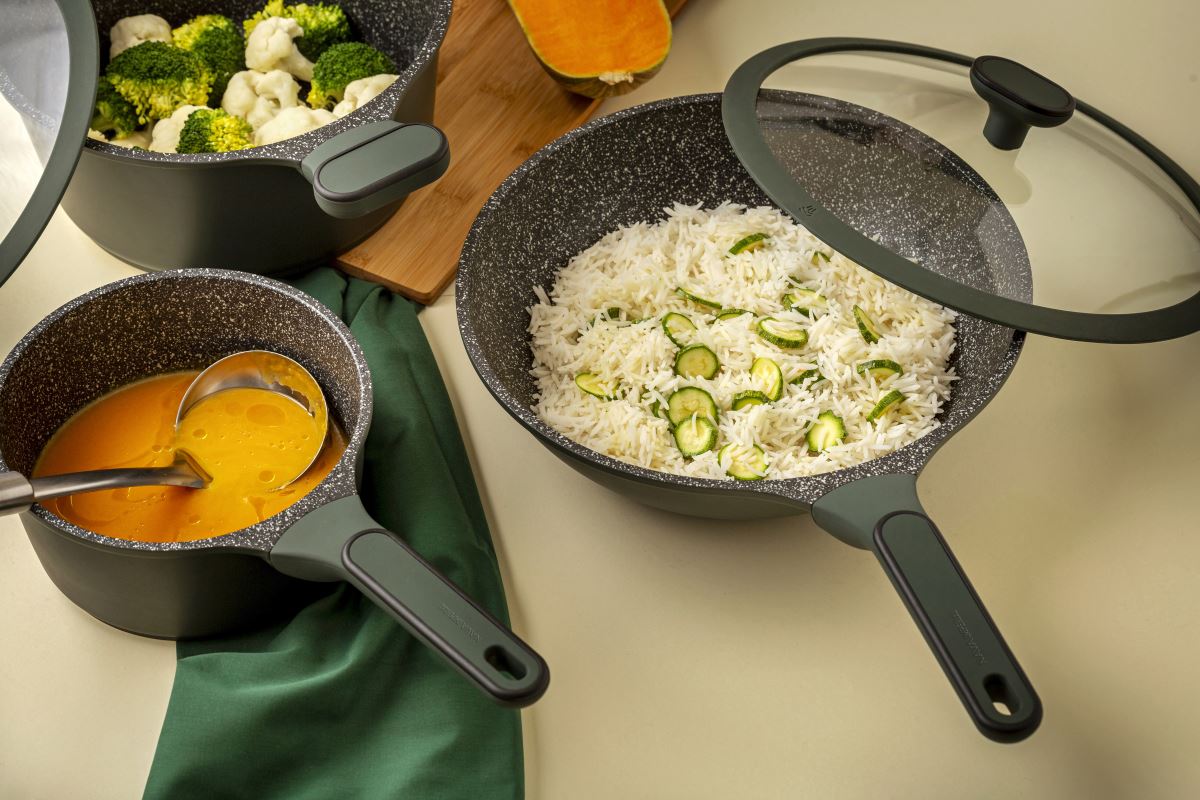Which is better, ceramic or non-stick cookware? look for the durability, safety, and performance of both options to find the perfect fit for your kitchen.
Choosing the right cookware is essential for any kitchen. Ceramic and non-stick options are popular choices, each with unique benefits. Ceramic cookware is known for being eco-friendly and free from harmful chemicals. Non-stick cookware, on the other hand, offers ease of use and quick clean-up.
Understanding the key differences can help you make an informed decision. In this blog, we will compare ceramic and non-stick cookware. We aim to help you determine which is better for your cooking needs. Ready to find the perfect cookware for your kitchen? Keep reading to learn more.
Introduction To Cookware Types
Choosing the right cookware can make a big difference in your cooking. Two popular options are ceramic and non-stick cookware. Each has its own benefits and drawbacks. Let’s explore the basics of both types to help you decide which is better for your kitchen.
Ceramic Cookware Basics
Ceramic cookware is known for its natural and non-toxic material. It is made from clay and other natural elements, which are fired at high temperatures. This process gives it a smooth, non-stick surface.
- Healthy Cooking: Ceramic cookware does not release harmful chemicals.
- Heat Distribution: It distributes heat evenly, which helps in cooking food uniformly.
- Durability: Ceramic is scratch-resistant and can last a long time.
However, ceramic cookware can be more prone to chipping if not handled carefully. It is also typically heavier than non-stick cookware.
Non-stick Cookware Basics
Non-stick cookware is often made from aluminum or stainless steel, coated with a non-stick surface like Teflon. This makes it very convenient for cooking and cleaning.
- Easy to Clean: Non-stick surfaces make cleaning effortless.
- Less Oil Needed: You need less oil or butter, making meals healthier.
- Lightweight: Non-stick cookware is generally lighter than ceramic.
One downside is that non-stick surfaces can wear off over time. It is also important not to use metal utensils with non-stick cookware, as they can scratch the surface.
In summary, both ceramic and non-stick cookware have their own advantages. Your choice depends on your cooking style and preferences.

Credit: madeincookware.com
Material Composition
When choosing between ceramic and non-stick cookware, understanding the material composition is essential. The materials used in each type of cookware affect their durability, safety, and cooking performance. Below, we delve into the details of both ceramic and non-stick cookware materials.
Ceramic Materials
Ceramic cookware is made from clay and other natural materials. The clay is hardened by firing it at high temperatures, creating a durable surface. Some key points about ceramic materials include:
- Natural Composition: Ceramic cookware is free from synthetic chemicals.
- Heat Resistance: Ceramic can withstand high cooking temperatures.
- Non-Toxic: It does not release harmful fumes when overheated.
- Eco-Friendly: Ceramic is biodegradable and environmentally friendly.
Non-stick Coatings
Non-stick cookware often features a coating made from synthetic materials like Teflon. The coatings provide a smooth surface that prevents food from sticking. Key aspects of non-stick coatings include:
- Ease of Use: Non-stick surfaces make cooking and cleaning easier.
- Chemical Composition: Commonly made from polytetrafluoroethylene (PTFE).
- Temperature Sensitivity: Overheating can release harmful fumes from the coating.
- Durability: Non-stick coatings can wear out over time and need careful handling.
| Aspect | Ceramic | Non-Stick |
|---|---|---|
| Material | Natural clay | PTFE/Teflon |
| Heat Resistance | High | Moderate |
| Safety | Non-toxic | Can release fumes |
| Eco-Friendly | Yes | No |
Cooking Performance
Choosing the right cookware impacts your cooking performance. Ceramic and non-stick options both have unique advantages. Let’s explore how each type performs in the kitchen.
Heat Distribution
Heat distribution affects cooking results. Ceramic cookware heats evenly. This prevents hot spots that could burn your food. Non-stick pans heat quickly but sometimes unevenly. This could lead to inconsistent cooking.
Food Release
Food release matters for ease of cooking and cleanup. Non-stick cookware excels in this area. Food slides off effortlessly. Ceramic cookware also performs well but may need some oil. Non-stick surfaces are often superior in preventing food from sticking.
:max_bytes(150000):strip_icc()/Ceramic-Vs-Nonstick-a6402473941449128c1434e9bac32d24.jpg)
Credit: www.thespruceeats.com
Health And Safety
Choosing between ceramic and non-stick cookware can be tough. Both have their pros and cons. This section will discuss the health and safety aspects of each type. We will delve into chemical concerns and heat tolerance.
Chemical Concerns
Ceramic cookware is often praised for its chemical-free nature. It does not contain harmful chemicals like PFOA or PTFE. These chemicals are found in some non-stick coatings. When heated, they can release toxins. This makes ceramic a safer option for health-conscious cooks.
Non-stick cookware, on the other hand, uses a coating that can wear down over time. Scratches can expose the metal underneath. This can lead to the release of chemicals into your food. To minimize risks, always use non-stick pans as directed.
Heat Tolerance
Ceramic cookware can withstand higher temperatures. This makes it ideal for high-heat cooking. You can use it in the oven and on the stove without worry. The high heat tolerance ensures that no harmful chemicals are released.
Non-stick cookware has a lower heat tolerance. Using it on high heat can damage the coating. This can release harmful fumes. Always cook on medium or low heat to keep your non-stick pans safe.
Here’s a quick comparison table for a better understanding:
| Aspect | Ceramic Cookware | Non-Stick Cookware |
|---|---|---|
| Chemicals | Free from PFOA and PTFE | May contain PFOA and PTFE |
| Heat Tolerance | High | Low to Medium |
| Durability | High | Moderate |
In summary, both types of cookware have their merits. Consider your cooking habits and health concerns when making a choice.
Durability And Longevity
When selecting cookware, durability and longevity are crucial factors to consider. The lifespan of your cookware impacts your budget and cooking experience. Let’s explore the durability and longevity of ceramic and non-stick cookware to help you make an informed decision.
Scratch Resistance
Ceramic cookware offers a sturdy surface that resists scratches. This makes it a great choice for long-term use. Metal utensils can be used without worrying about damaging the surface. Non-stick cookware, on the other hand, is prone to scratches. Using metal utensils can harm the coating, reducing its lifespan. Opt for wooden or silicone utensils to maintain the non-stick surface.
Wear And Tear
Ceramic cookware is known for its ability to withstand wear and tear. The material can endure high temperatures and rough handling. It retains its look and functionality over time. Non-stick cookware is less resistant to wear and tear. Over time, the coating may peel or flake off. This can affect the non-stick properties and overall performance. Regular care and proper use can extend the life of non-stick cookware, but it may still require replacement sooner than ceramic.

Credit: madeincookware.com
Ease Of Maintenance
Maintaining your cookware can be a deciding factor in your purchase. Both ceramic and non-stick cookware have their own maintenance needs. Let’s explore the ease of maintenance for each type.
Cleaning Methods
Ceramic cookware is often dishwasher safe. This makes cleaning a breeze. You can also hand wash with mild soap and water. Avoid using abrasive sponges. They can damage the surface. Non-stick cookware needs more care. Hand washing is usually recommended. Use a soft sponge and mild detergent. Avoid the dishwasher if possible. High heat can damage the coating.
Stain Resistance
Ceramic cookware resists stains well. The smooth surface repels food and liquids. Most stains can be removed with a gentle wipe. Non-stick cookware also resists stains. The coating prevents food from sticking. This makes it easy to clean. Stubborn stains are rare.
Environmental Impact
Considering the environmental impact of cookware is important. Both ceramic and non-stick cookware have distinct environmental footprints. Understanding their production processes and recyclability can help make an informed choice.
Production Processes
The production process for ceramic cookware involves natural materials. These include clay, water, and minerals. The process requires high temperatures to harden the clay. This can lead to significant energy use. Non-stick cookware, on the other hand, involves synthetic materials. The coating is usually made from polytetrafluoroethylene (PTFE). Producing PTFE involves chemicals and high energy consumption. This process may release harmful gases.
Recyclability
Ceramic cookware is not easily recyclable. The materials used are difficult to break down and reuse. This can lead to waste in landfills. Non-stick cookware faces similar issues. The synthetic coating is not biodegradable. It complicates the recycling process. Both types require proper disposal methods to minimize environmental harm.
Cost Comparison
When choosing between ceramic and non-stick cookware, cost is a major factor. Understanding the financial aspects can help you make an informed decision. This section breaks down the cost differences between ceramic and non-stick cookware.
Initial Investment
The initial cost of ceramic cookware is usually higher. These pieces often boast a sleek design and durable materials. You may need to spend more upfront, but the quality often justifies the price.
Non-stick cookware tends to be more affordable. It is a budget-friendly option for many households. This makes it an attractive choice for those looking to save money initially.
Long-term Value
Ceramic cookware offers great long-term value. It is known for its longevity and durability. With proper care, ceramic pieces can last many years, making them a wise investment.
Non-stick cookware may need to be replaced more frequently. The non-stick coating can wear off over time. This could lead to higher long-term costs despite the lower initial price.
Both options have their financial pros and cons. Consider your budget and cooking habits when making a decision. Choosing the right cookware can enhance your culinary experience while being cost-effective.
Expert Recommendations
Choosing the right cookware can make a big difference in the kitchen. Expert recommendations can help you decide between ceramic and non-stick options. Both types have their strengths and are suitable for different cooking needs. Below, we explore the best uses for everyday cooking and specific dishes.
Best For Everyday Cooking
Experts often recommend non-stick cookware for daily use. It heats up quickly and evenly. Non-stick surfaces require less oil, making meals healthier. Cleaning is a breeze since food doesn’t stick. Ideal for busy individuals who cook often. Non-stick pans are also lightweight and easy to handle. Perfect for quick meals and regular use.
Best For Specific Dishes
Ceramic cookware shines in cooking specific dishes. It’s excellent for slow-cooked meals. Ceramic retains heat well, making it ideal for simmering sauces. It adds a touch of elegance to your kitchen. Perfect for dishes that require even cooking. Ceramic is also free from harmful chemicals. Safe for high-temperature cooking and baking. Best for making casseroles, soups, and stews.
Frequently Asked Questions
Which Is Better For Health, Ceramic Or Non-stick?
Ceramic cookware is generally considered healthier. It is free from toxic chemicals. Non-stick coatings can release harmful fumes at high temperatures.
Does Ceramic Cookware Last Longer Than Non-stick?
Ceramic cookware can last longer if properly maintained. Non-stick coatings may wear off over time, reducing their lifespan.
Is Ceramic Cookware More Expensive Than Non-stick?
Ceramic cookware can be more expensive. However, prices vary based on brand and quality. Non-stick cookware is often more affordable.
Can Ceramic Cookware Be Used On All Stovetops?
Yes, ceramic cookware is versatile. It works on gas, electric, and induction stovetops. Always check manufacturer guidelines.
Conclusion
Choosing between ceramic and non-stick cookware depends on your needs. Ceramic is great for high heat and durability. Non-stick is perfect for easy cooking and cleaning. Consider your cooking habits and preferences. Both types have unique benefits. Think about health, ease of use, and longevity.
Make an informed decision based on your kitchen routine. Each option offers something valuable. Happy cooking!
